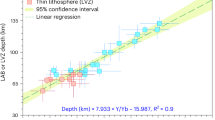Abstract
RECENTLY, Ben-Menahem et al.1 derived tectonic patterns and slip rates in the Jordan Rift Valley by combining a comprehensive study of seismological, historical, geological and morphological data. It was found that the principal seismic activity along the Jordan Valley is due to a left-lateral strike-slip fault, striking 11° east of north and extending for about 50km from 32°N to 31°30′N along the 35° 30′meridian. Its most active part in the past four millenia has been near the monastery of John the Baptist which, according to tradition, is the place where the Israelites crossed the Jordan and where Jesus was baptised. The fault trace and its role in the historical seismicity of the area is shown in Fig. 1. It has an estimated mean rate of activity of 2–3 events per century at magnitudes from 5 to 7 (ref. 1). An aseismic slip rate of at least 3 mm yr−1 is taking place along this fault1. Here we show how this activity is reflected in an unusual limnological process which takes place at the bottom of the Dead Sea and which can serve as a ‘geophysical clock’ to date historical events.
This is a preview of subscription content, access via your institution
Access options
Subscribe to this journal
Receive 51 print issues and online access
$199.00 per year
only $3.90 per issue
Buy this article
- Purchase on Springer Link
- Instant access to full article PDF
Prices may be subject to local taxes which are calculated during checkout
Similar content being viewed by others
References
Ben-Menahem, A., Nur, A., and Vered, M., Phys. Earth. planet. Int. (in the press)
Willis, B., Bull. seism. Soc. Am., 18, 73–103 (1928).
Sieberg, A., Handbuch der Geophysik IV (Borntrager Verlag, Berlin, 1932).
Amiran, D., Israel Explor. J., 1, 223–239 (1951).
Ambraseys, N. N., Bull. seism. Soc. Am., 52, 895–913 (1962).
Elazari-Volcani, B., Nature, 152, 274–275 (1943).
Perfiliev, B. W., Ver. int. Verein. theor. angew. Limnol., 4, 215–219 (1929).
Ashbel, D., Bull. Palestine Explor. Soc., 11, 57–58 (1943).
Author information
Authors and Affiliations
Rights and permissions
About this article
Cite this article
BEN-MENAHEM, A. Dating of historical earthquakes by mud profiles of lake-bottom sediments. Nature 262, 200–202 (1976). https://doi.org/10.1038/262200a0
Received:
Accepted:
Published:
Issue Date:
DOI: https://doi.org/10.1038/262200a0
This article is cited by
-
Dating earthquakes by mud profiles of lake sediments (reply)
Nature (1977)
-
Dating earthquakes by mud profiles of lake sediments
Nature (1977)
Comments
By submitting a comment you agree to abide by our Terms and Community Guidelines. If you find something abusive or that does not comply with our terms or guidelines please flag it as inappropriate.



